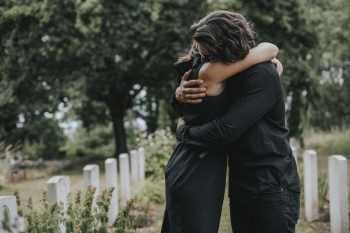
Going to therapy always feels like a big decision, no matter what. Sometimes, seeking therapy after a loss can feel especially overwhelming, especially because of all of the harmful messages society tells us about grief and loss: that grieving involves finding closure, has a time limit, and shouldn’t interfere with your daily life. These are popular myths and misconceptions based on society’s own discomfort facing death and loss. It’s true, grief is hard to talk about, and grievers can be made to feel, even by their closest friends and family, that there isn’t time or space for their feelings. This is why it’s especially important to think about going to therapy, particularly when you’ve lost a baby or pregnancy. Babyloss is one of the hardest things to talk about, because if society is uncomfortable about grief in general, opening up about the loss of a child is even harder. Talking about babyloss means defying commonly-held beliefs about the natural order of life and death, and challenges the stereotype that children don’t die before their parents. A specialized therapist who works with grief and babyloss can create a safe space for you to unpack and face the numerous thoughts and feelings you have about your loss, as well as how you feel about trying for another baby. While these tips are meant to do the same thing, there is truly no replacement for therapy.
So, what does babyloss therapy look like? Therapy always involves an intake process, where you tell your story and answer questions about your own mental health and physical history. While some of the questions might seem intrusive, providing honest information can help your therapist get to know you best as well as start to plan out an individualized plan of treatment. A good therapist never judges their client’s past history, and should make you feel safe and comfortable. They are sworn to confidentiality, provided you do not give information about imminently harming yourself or others. Seasoned clinicians, and even newer ones, quite quickly, become accustomed to hearing information that others might find shocking or taboo. The job of a therapist is to help and support you through all of it.
When it comes to babyloss, therapy can follow a specialized course, identified by the acronym, ACCEPT. Each letter of “ACCEPT” stands for a stage of therapy that is designed specifically for parents who have loved and lost a baby, and especially those who have experienced ending a wanted pregnancy. It’s important to know that this is not a stage-based model, and each phase or letter can happen out of order, and multiple times. The “ACCEPT” model is holistic in this way.
A stands for Acknowledge disenfranchised grief. As has been explained in other entries, disenfranchised grief refers to mourning that is sanctioned by society as not worth of support or validation. This is usually because it violates traditional norms and stereotypes about grief. As discussed above, babyloss can feel disenfranchised because it makes others uncomfortable, and few people want to acknowledge how losing a child feels out of order and threatening. Parents who have experienced pregnancy loss often find that others don’t view their loss as “real” because the baby never lived outside of the womb, while those who had a stillbirth or perinatal loss can feel isolated from other groups of grievers whose children lived longer lives. For parents who have ended a wanted pregnancy, grief is especially disenfranchised because it involves abortion and moral judgments. These grieving parents can feel especially silenced and judged during a time when they need to grieve openly and be met by unconditional understanding and support. Thus, acknowledging disenfranchised grief, learning about it, and how it shows up during the grieving process, is essential.
C stands for Connecting emotions to the loss. Often, grievers tell themselves that they “should” be healed by now, and they don’t often recognize that as they move forward in life, their grief will follow and affect them in numerous ways. Thus, connecting emotions to the loss in therapy encourages a client to reflect upon moments, both recent and past, since the loss, where they have felt sadness, despair, anger, irritability, or other strong emotions. Babyloss grievers tend to discredit how easily they might be triggered in seemingly unrelated situations following their loss. They do not view babyloss as all-encompassing or creating an additional painful context or shading to work, relationships, and leisure activities. For example, a grieving parent may suddenly feel overcome by irritability during a work meeting, and not realize that perhaps they are irritable because they should have been on maternity leave by now, not sitting in a work meeting. There are numerous instances where grief shows up and affects our emotions, and part of the “work” in therapy involves identifying it when it does.
The second C stands for Continuing bonds. There is an entire self-help tip dedicated to this important work in therapy and in life following loss. As a reminder, remaining connected to the baby you lost is an important way to move through grief and find meaning. This can involve creating rituals to acknowledge their life and effect of that life on yours; saving special items like ultrasound photos; keeping a journal or writing letters to your baby, and other activities.
The next letter in the “ACCEPT” acronym, E, stands for Exploring and challenging distortions. Often, grievers feel irreparably “changed” by their losses, and develop negative or unrealistic expectations about themselves as a result. Therapy involves identifying and challenging these unhelpful beliefs and replacing them with healthier and more accurate substitute thoughts. Typical distortions after babyloss include “My body failed me”; “I will never be able to have a healthy pregnancy”; or “My life is ruined”. It is understandable that these thoughts will arise, and they may even be your mind’s way of protecting itself from future harm by assuming the worst, though nothing can ever truly prepare you for loss and its influence over your life. Becoming aware of unhelpful thoughts and challenging them is always a healthy way to heal, even outside of the therapist’s office. This challenge piece is also accompanied by the P in “ACCEPT”, or Practicing new skills. It isn’t enough to talk about change; practice is essential! Your therapist will provide you with homework to help you do first identify and document distortions, and then will practice in-session the ways you can challenge these in order to continue your work outside of the session.
Finally, the T stands for Telling the story. You can tell your loss story at any time, and you do not need storytelling to wait until you’ve been through therapy. Rather, the process of creating a narrative of your loss, like the “ACCEPT” model, is circuitous and holistic. As your life moves forward and you learn to create meaning from your loss, your babyloss story will change, grow, and become richer. You will begin to feel validated in telling it, and replace harmful assumptions with healthier ones.
Your loss story is unique, and valid, and always deserves to be told, no matter what. The ACCEPT model is only one modality of therapy that can be helpful, but there are others. Consider meeting with a therapist and exploring with them what methods they use and how they can be helpful to you as you learn to live with your loss.
You can self schedule an in-person or virtual therapy session at the Center for Growth by calling (215) 922- LOVE (5683) x 100.
Our Guarantee: If after your first session you are not sold that you are working with the right therapist, do not hesitate to call our intake line at 215 922 5683 x 100 or Alex at (267) 324-9564 and ask to be rescheduled with another therapist. The choice of how you want to proceed is yours. Our only goal is to support you in becoming the best you possible.
For your convenience, we have brick and mortar offices and work with clients virtually in Connecticut, Delaware, Florida, New Jersey, New Mexico, Pennsylvania, and Virginia.
Physical Therapy Office Locations:
Ocean City Therapy Office 360 West Ave, Floor 1, Ocean City, NJ 08226
Mechanicsville Therapy Office 9044 Mann Drive, Mechanicsville Virginia, 23116
Society Hill Therapy Office 233 S. 6th Street, C-33, Philadelphia PA 19106
Art Museum / Fairmount Therapy Office 2401 Pennsylvania Ave, Suite 1a2, Philadelphia PA 19130
Providence Therapy Office 173 Waterman St. Providence, RI 02906
Fayetteville Therapy Office 101 Devant Street #606, Fayetteville GA 30214
Santa Fe Therapy Office, 2204 B Brothers Road, Santa Fe, New Mexico, 87505
Telemedicine Therapy Locations: We have therapists who are licensed to work in Connecticut, Delaware, Florida, Georgia, New Jersey, New Mexico, Pennsylvania and Virginia and Pennsylvania
Therapy Services Offered in Fayetteville, Ocean City, Mechanicsville, Philadelphia, Providence, Santa Fe:
Individual Counseling and therapy
Couples Counseling and marriage counseling
Teen Therapy and Adolescent Therapy and tweens and child counseling
Family Therapy and multi-generational counseling
Art Therapy and Counseling no art skills needed
ADHD Therapy and ADD, Dyslexia, Autism, Tourettes counseling
Anxiety, Panic, OCD Therapy and worry and fear support
Breaking the cycle of Codependency and being your own person
Overcoming Chronic Illness and Chronic Pain .
Depression Therapy and sadness, gloom, and upset support
Functional Neurological Disorder (FND) Therapy is a particular style of therapy designed for people with problems affecting their nervous system, how the brain and body send and receive signals.
Grief Therapy and loss, End of A Relationship, rejections, pregnancy and loss and therapy
Mindfulness Based Therapy and spirituality based therapy
Narcissistic Abuse Recovery child of, parent of, spouse of, sibling of a narcissist.
Sex Therapy and sexual function & dysfunction, sex addiction, sexual orientation and gender identity support
Trauma Therapy both emotional and sexual abuse, complex trauma, PTSD counseling
Divorce support
Affairs, Infidelity, Unfaithful, Cheating counseling
Parenting therapy
Personality disorder treatments Narcissist, Borderline, Histrionic
Setting Boundaries and identifying ones own Core Beliefs
Just name some of the Mental Health issues that we work with. Our goal is to help you Change and Achieve Your Dreams













